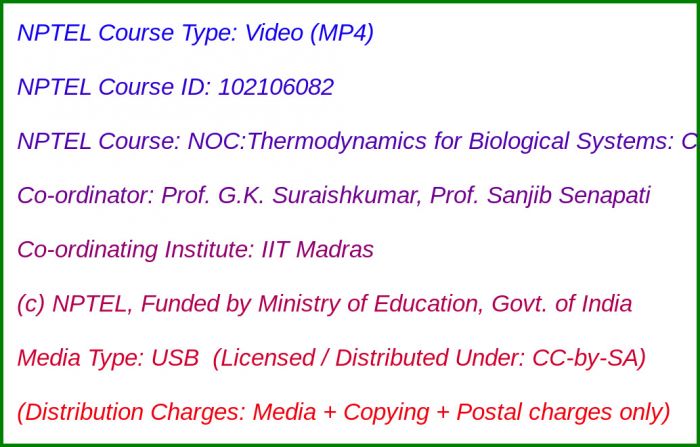NOC:Thermodynamics for Biological Systems: Classical and Statistical Aspect (USB)

Media Storage Type : 64 GB USB Stick
NPTEL Subject Matter Expert : Prof. G.K. Suraishkumar, Prof. Sanjib Senapati
NPTEL Co-ordinating Institute : IIT Madras
NPTEL Lecture Count : 87
NPTEL Course Size : 39 GB
NPTEL PDF Text Transcription : Available and Included
NPTEL Subtitle Transcription : Available and Included (SRT)
Lecture Titles:
Lecture 1 - Introduction and review
Lecture 2 - Review (Continued...)
Lecture 3 - Need for analysis
Lecture 4 - Additional Thermodynamic Functions
Lecture 5 - State and Path Variables
Lecture 6 - Equations for a Closed System
Lecture 7 - Chemical Potential
Lecture 8 - Gibbs Duhem equation
Lecture 9 - Maxwell’s relations
Lecture 10 - Inter-relationships between thermodynamic variables (Continued...)
Lecture 11 - Some useful mathematical manipulations
Lecture 12 - Thermodynamic relations for a closed system with 1 mole of pure substance
Lecture 13 - Maximum work
Lecture 14 - Open systems
Lecture 15 - Equations of state - Virial equations
Lecture 16 - Equations of state - Cubic equations
Lecture 17 - Volume estimation
Lecture 18 - Volume estimation (Continued...)
Lecture 19 - Generalized correlations
Lecture 20 - Generalized correlations (Continued...)
Lecture 21 - Residual properties
Lecture 22 - Residual properties (Continued...)
Lecture 23 - Generalized correlations and residual properties
Lecture 24 - Fugacity coefficient estimation
Lecture 25 - Review of module 3
Lecture 26 - Learning aspects
Lecture 27 - Chemical potential formulations
Lecture 28 - Lewis and Randall rule
Lecture 29 - Partial molar properties
Lecture 30 - Partial molar property estimation from mixing experiments
Lecture 31 - Partial molar property estimation (Continued...)
Lecture 32 - Activity coefficient from excess property
Lecture 33 - Activity coefficient from excess property (Continued...)
Lecture 34 - Models for activity coefficient in a binary system
Lecture 35 - Models for activity coefficient for a binary system (Continued...)
Lecture 36 - Review of module 4
Lecture 37 - Criteria for phase equilibrium
Lecture 38 - Phase rule for non-reacting systems
Lecture 39 - Clausius Clayperon equation
Lecture 40 - Clausius Clayperon equation (Continued...)
Lecture 41 - Vapour liquid equilibrium
Lecture 42 - Vapour liquid equilibrium (Continued...)
Lecture 43 - Estimation of fugacity coefficient from P-V-T data at equilibrium
Lecture 44 - Liquid-liquid and solid-liquid equilibria
Lecture 45 - Review of module 5
Lecture 46 - Criteria for bioreaction equilibria
Lecture 47 - Phase rule for reacting biosystems
Lecture 48 - Equilibrium constants
Lecture 49 - Effect of temperature on the equilibrium constants
Lecture 50 - Reaction in liquid or solid phases
Lecture 51 - Free energy changes for some bioreactions
Lecture 52 - Electrolytes
Lecture 53 - Review of the classical thermodynamics part
Lecture 54 - Introduction to Statistical thermodynamics
Lecture 55 - Concepts of macro and microstates
Lecture 56 - Thermodynamic probability
Lecture 57 - Boltzmann distribution law
Lecture 58 - Defining β in Boltzmann distribution law
Lecture 59 - Relationship between partition function and thermodynamic quantities
Lecture 60 - Partition function of mono atomic gases
Lecture 61 - Entropy in terms of probablity
Lecture 62 - Gibbs paradox
Lecture 63 - Thermodynamic probability for distinguishable particles
Lecture 64 - Thermodynamic probability for indistinguishable particles
Lecture 65 - Sackur - Tetrode equation
Lecture 66 - Partition function and Helmholtz and Gibbs free energy
Lecture 67 - Ensemble approach
Lecture 68 - Ensemble average, time average, Ergodic hypothesis
Lecture 69 - Partition function for classical systems
Lecture 70 - Pair potentials for atomic systems
Lecture 71 - Potential for molecular systems
Lecture 72 - Computer code for LJ potential
Lecture 73 - Introduction to computer simulations
Lecture 74 - Computer simulations of macromolecules
Lecture 75 - MD simulation examples
Lecture 76 - Link between theory and experiments
Lecture 77 - MD protocol
Lecture 78 - Computer simulation tricks
Lecture 79 - Understanding force fields
Lecture 80 - Idea of Z-matrix
Lecture 81 - Basics of MD simulations
Lecture 82 - Integration algorithms
Lecture 83 - Calculation of Columbic force
Lecture 84 - Calculation of LJ force
Lecture 85 - Monte Carlo simulations
Lecture 86 - Analysis of MD trajectory
Lecture 87 - Case study (water)

